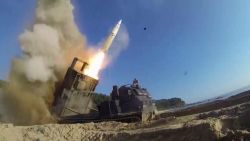Ukraine hit a Russian weapons arsenal with US-made ATACMS missiles that it fired across the border for the first time, according to two US officials, in a major escalation on the 1,000th day of war.
The attack comes just two days after the Biden administration gave Kyiv the green light to use the longer-range American weapons against targets inside Russia.
Russia’s Defense Ministry said Ukraine fired six ballistic missiles at a facility in Bryansk at 3:25 a.m. local time (7:25 p.m. ET) Tuesday and that ATACMS missiles had been used in the attack
The attack marks the first time Ukraine has used the longer-range American weapons to strike targets deep inside Russia, and shows that Kyiv has wasted little time in making use of its newly-granted powers.
Ukrainian President Volodymyr Zelensky declined to confirm or deny the attack during a Tuesday news conference but said: “Ukraine has long-range capabilities. Ukraine has long-range drones of its own production. We now have a long ‘Neptune’ (Ukrainian cruise missiles) and not just one. And now we have ATACMS. And we will use all of this.”
Russian air defenses said they shot down five of the missiles and another was damaged. Fragments from the damaged missile fell on the territory of a military facility, causing a fire that has since been extinguished. There were no casualties or damage.
On the same day of the attack, Russian President Vladimir Putin updated Russia’s nuclear doctrine where Moscow will consider aggression from any non-nuclear state – but with the participation of a nuclear country – a joint attack on Russia.
In what appeared to be a fresh round of saber rattling, the Kremlin said Tuesday the revised military doctrine would, in theory, lower the bar to the use of nuclear weapons.
US President Joe Biden had authorized Ukraine to use longer-range American missiles inside Russia on Sunday, ending a months-long prohibition aiming to help Ukraine defend itself while not drastically escalating the conflict.
The decision came at a crucial moment in Russia’s invasion of Ukraine. Russia is probing on the frontlines in Ukraine’s east while pummeling its cities with missile and drone strikes, aiming to disable Ukraine’s power grid and weaponize the freezing temperatures for a third consecutive winter.
Meanwhile, thousands of North Korean troops have been deployed to Russia’s Kursk region, where Ukrainian troops launched a daring counteroffensive in the summer.
In a press briefing Monday, US State Department spokesperson Matthew Miller said the involvement of North Korean troops in the war was “a major escalation by Russia, bringing in an Asian military to a conflict inside Europe.”
The decision to allow the use of the Army Tactical Missile Systems, or ATACMS, inside Russia had been under consideration for months, with American officials divided on the wisdom of allowing the new capability. Some had concerns about escalating the war, while others worried about dwindling stockpiles of the weapons.
Other Western allies remain more cautious. At the G20 summit in Brazil on Tuesday, German Chancellor Olaf Scholz reiterated his stance of withholding Taurus missiles from Ukraine, adding that “supplying cruise missiles would be a mistake.”
Although Kyiv has repeatedly used Ukrainian-made drones to hit targets in Russia – deeper into the country than Bryansk – Moscow has long maintained that using far-reaching Western weapons would constitute a major escalation.
Russian Foreign Minister Sergey Lavrov said Tuesday that Moscow will view launches of US-made longer-range missiles as a “new phase of war” by the West.
American officials said they were unsurprised by the news of Putin updating Russia’s nuclear doctrine. “Russia had been signaling its intent to update its doctrine for several weeks,” a US official told CNN.
Pentagon Deputy Press Secretary Sabrina Singh said at a briefing that the US doesn’t have any indications that Russia is preparing to use a nuclear weapon within Ukraine, adding, “It’s the same irresponsible rhetoric that we’ve seen before and that we’ve seen, frankly, for the past two years.”

In more than two-and-a-half years of war, Russia has often rattled the nuclear saber in response to perceived escalation by Ukraine and its allies.
After French President Emmanuel Macron said earlier this year that he would not rule out sending European troops to Ukraine, Putin ordered a tactical nuclear weapons drill in response to what he called “threats” by the West.
For months, Ukraine’s President Zelensky had argued that “long-range capabilities for our army” is a key part of his “Victory Plan” for winning the war.
Responding on Sunday evening to reports of Biden’s green-light, Zelensky said: “Strikes are not carried out with words. Such things are not announced. Missiles will speak for themselves.”
CNN’s Natasha Bertrand, Daria Tarasova-Markina, Kevin Liptak, Michael Conte and Chris Stern contributed to this report.






